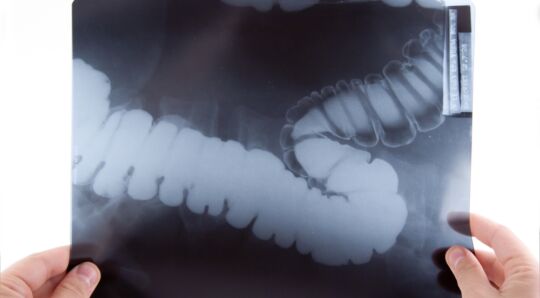Key points
- Abdominal pain is one of the most common patient presentations in general practice. However diagnostic imaging is often not indicated or helpful for investigating chronic abdominal pain.
- Determine if imaging is needed for your patient based on patient history, the results of physical examination, selected pathology tests if appropriate and considering the probability of disease.
- To ensure an imaging referral is justified, consider whether the results will assist in diagnosis and patient management.
- Having a provisional diagnosis and clear clinical question in mind can help focus the investigation, and noting these in the referral can assist the radiologist's interpretation of results.
- Clinical guidelines are available from the Diagnostic Imaging Pathways, and can help you to select the most appropriate diagnostic imaging test for your patient.
Practice Review – Optimising imaging referrals for chronic abdominal pain

Australian GPs recently received a Practice Review designed to assist with reflection on referrals for selected MBS imaging services of the abdomen and pelvis.
It was developed in collaboration with GPs and has been sent to approximately 30,000 medical practitioners nationally, including all GPs.
- Access a sample report
- Read FAQs about the MBS Practice Review and how to interpret and understand your data
- Find regional and national data about imaging referrals for selected MBS imaging services of the abdomen and pelvis.
- Access a sample report
- Read FAQs about the MBS Practice Review and how to interpret and understand your data
- Find regional and national data about imaging referrals for selected MBS imaging services of the abdomen and pelvis.
Essentials in an imaging referral

Referral information directly impacts on patient care and safety. Always including relevant clinical details in an imaging referral will focus the investigation and assist in the radiologist's interpretation of results.
The details include signs, symptoms and location of pain, provisional diagnosis, the clinical question being addressed, and red flags for particular conditions.
Read our list of the essentials in a quality imaging referral
When and what kind of imaging should you choose?
For a patient presenting with chronic abdominal pain, basic investigations including patient history, physical examination and simple blood tests may reveal findings of concern, abnormal results or red flag symptoms.
Imaging may be appropriate when:
- the probability of disease in the patient has been considered
- the imaging test will assist in diagnosis and/or inform patient management
- a clear, specific question is being asked of the test – to focus the interpretation of results.
Quality use of medical tests means choosing the right test for the patient and using it at the right time. Read about the evidence and guidelines on medical imaging for abdominal pain.
Choosing Wisely Australia

Choosing Wisely Australia helps healthcare providers and consumers have important conversations about improving the quality of healthcare by reducing unnecessary and sometimes harmful tests, treatments, and procedures.
Led by Australia’s colleges, societies and associations and facilitated by NPS MedicineWise, Choosing Wisely Australia challenges the way we think about healthcare, questioning the notion 'more is always better'.
5 questions to ask your doctor or other healthcare provider is a resource that can help patients ensure they end up with the right amount of care.
See the Choosing Wisely recommendations on abdominal pain
Recommendation from the Royal Australian College of General Practitioners
Australian Prescriber: Imaging for chronic abdominal pain in adults

Richard Mendelson
Aust Prescr 2015;38:49-541 Apr 2015
Chronic abdominal pain is common in primary care, but diagnostic imaging is often not needed . When imaging is indicated, a CT scan may not be the ideal investigation. Ultrasound, CT and MRI all have their advantages and disadvantages.
Australian Prescriber: Treatment of irritable bowel syndrome

Chamara Basanayke
Aust Prescr 2018;41:145-9 Oct 2018
Irritable bowel is chronic functional gastrointestinal disorder with abdominal pain. A positive diagnosis should be based on the presence of characteristic symptoms and absence of red flags. Red flags should prompt imaging or specialist referral.
Resources and tools
Australian guidelines and information
- Diagnostic Imaging Pathways (DIP)
Australian diagnostic imaging guidelines from the WA Department of Health to help you choose the best imaging test for your patient. - Ionising radiation and health
Information from the Australian Radiation Protection and Nuclear Safety Agency - Pitman A. Quality of referral: What information should be included in a request for diagnostic imaging when a patient is referred to a clinical radiologist? J Med Imaging Radiat Oncol 2017;61:299-303
Referral to a radiologist is the prime means of communication between the referrer and radiologist. High quality information provided in a referral allows the radiologist to ensure that the exposure to radiation is justified and minimises the diagnostic error.
For your patients
5 Questions to ask your doctor or other healthcare provider

Choosing Wisely Australia helps healthcare providers and consumers have important conversations about improving the quality of healthcare by reducing unnecessary and sometimes harmful tests, treatments, and procedures.
Led by Australia’s colleges, societies and associations and facilitated by NPS MedicineWise, Choosing Wisely Australia challenges the way we think about healthcare, questioning the notion 'more is always better'.
5 questions to ask your doctor or other healthcare provider is a resource that can help patients ensure they end up with the right amount of care.

